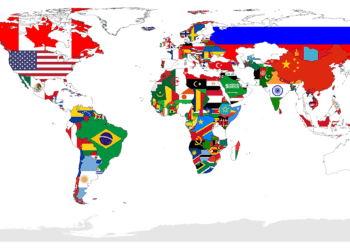
Some countries are long and thin, others compact and nearly symmetrical. Some follow natural curves, while others have borders drawn with a ruler. But these shapes are not random — they reflect history, geography, and politics. Wars, rivers, and colonial boundaries have all played a role in shaping nations. But what if we could measure a country’s shape mathematically, which one would be the roundest?
Believe it or not, someone did the math.
The roundest country: Sierra Leone
If you look at Sierra Leone on a map, its borders seem to trace an almost perfect curve. It’s almost like someone pressed an old coffee mug onto a parchment map and traced the outline. If you compare it to Egypt’s hard, straight edges, you’d assume these two countries couldn’t be more different in shape. But here’s the twist: Sierra Leone, the roundest country in the world, is also among the most rectangular.
The quest for the world’s roundest country started with Argentine mathematician Gonzalo Ciruelos, who devised a method to compare a country’s shape to an ideal circle. His algorithm analyzed all possible circles that could overlap a given country and determined the best fit. The closer the match, the higher the roundness score, with a perfect circle scoring 1.

Sierra Leone emerged victorious, scoring an impressive 0.934, with Zimbabwe (0.915) and Poland (0.907) close behind. We’ll get to the Vatican in a moment.
Meanwhile, elongated island nations like Japan and the Maldives landed at the bottom of the roundness rankings. Zimbabwe may have finished first if it wasn’t for the Hwange region that reduces the country’s circle of Optimal Rotundity.

The squarest country: Egypt
On the other side of the mathematical spectrum, Australian geo-statistician David Barry took a different approach. He aimed to identify the most rectangular country — one whose borders align closely with an optimal rectangle of the same area. Using his method, Egypt topped the list with a near-perfect rectangularity score of 0.955. The Vatican, surprisingly, was the second-most rectangular country, with Sint Maarten, a constituent country from the Kingdom of Netherlands also looking strikingly rectangular.
Both the Vatican and Sierra Leone came up pretty high for being both round and rectangular at the same time. Funnily enough, it’s also the same countries that are both the least round and rectangular: on 208th and last place, the Maldives are the world’s least rectangular country, followed by the Marshall Islands (on 207). That same Pacific archipelago is also the world’s least round country, with the Maldives trailing just four places behind.

So what does this teach us? Little of any practical value, except this: the fact that the Vatican scores pretty high on both lists has nothing to do with divine intervention. Contrary to common sense, countries can be both very rotund and very rectangular at the same time.
This paradox — that some of the most rectangular nations are also among the most round — might seem like a contradiction. But the reason lies in how these shapes are measured. A country with smooth, gently curved borders can score highly in both categories. Sierra Leone, for instance, isn’t jagged or sprawling. It has a nearly enclosed shape, making it both circular and neatly rectangular.
When it comes to the Vatican, there’s a catch, however. Many mapping databases simplify small countries’ outlines, making them appear more regular than they truly are. In reality, the Vatican’s actual borders are irregular and jagged, especially when traced along the famous Leonine Walls.
What does this tell us about countries?
There’s not much useful information hidden in this stat. However, we can glean a bit of information from this. Compact countries (both round and square) tend to have fewer internal divisions and more centralized governance. Meanwhile, elongated or fragmented nations — such as Chile or Indonesia — face logistical challenges in transportation, communication, and administration.
The way we measure shapes can also expose hidden patterns in geopolitics. Borders drawn with straight lines, like those of Egypt or many African nations, often reflect colonial history rather than natural geographic or cultural boundaries. Countries with more irregular borders, like Norway or the United States, tend to have more diverse landscapes and ecosystems.
Countries’ shapes are not merely geometric facts — they’re stories, written over centuries, of human settlement, conflict, and adaptation to the land. But it’s interesting to look at them through a different lens.






